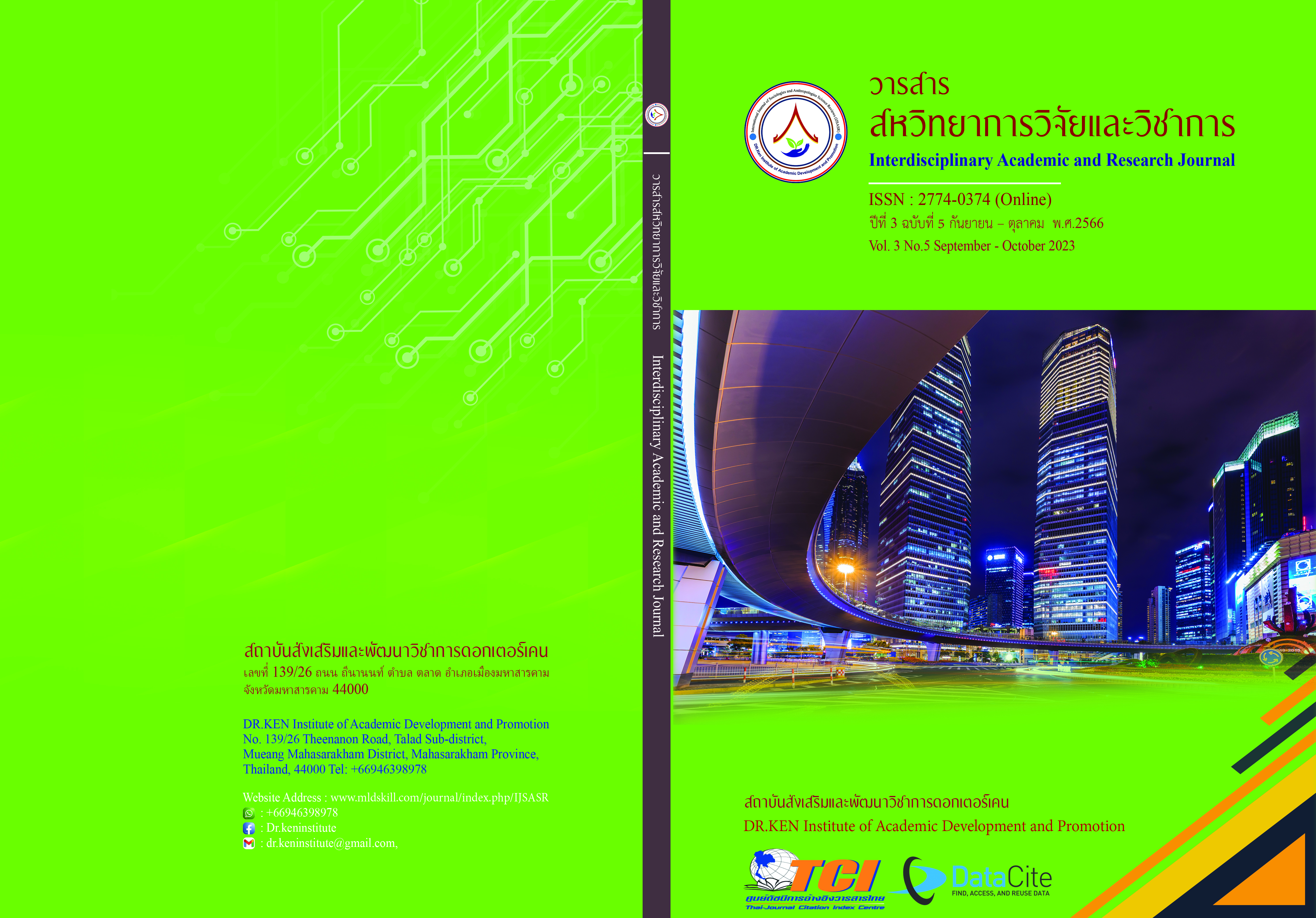The Development of Mathematics Learning by Using Inquiry-based Learning Management (5E) Combined with Higher order Questioning of Grade 8 Students
DOI:
https://doi.org/10.14456/iarj.2023.249Keywords:
Mathematics Learning; , Inquiry-Based Learning Management (5E);, Higher Order QuestionsAbstract
The development of mathematics learning by using inquiry-based learning management (5E) combined with higher order questioning of grade 8 students had the objectives of (1) to develop inquiry-based learning management (5E) combined with higher order questioning of grade 8 students to be effective according to the 70/70 criterion. (2) to study the mathematics learning outcomes of grade 8 students after receiving inquiry-based learning management (5E) combined with higher-order questioning. and (3) to compare the mathematics learning outcomes of grade 8 students after receiving inquiry-based learning management (5E) combined with higher-order questioning against the 70 percent threshold. The sample used in the research was 40 students in grade 8, room 2/9, Wapi Pathum School. The research tools were learning management plans using inquiry-based learning management (5E) combined with higher-order questioning and math learning quizzes. The data was analyzed using written analysis, analytical lectures, and basic statistics, including mean, percentage, and standard deviation and the statistics used to test the hypothesis were One Sample test. The results showed that (1) the learning management with inquiry (5E) combined with higher-order questioning of grade 8 students was effective at 75.28/78.23. (2) Mathematics learning outcomes of grade 8 students after receiving inquiry-based learning management (5E) combined with higher-order questioning at a very good level, and (3) Mathematics learning outcomes of grade 8 students after receiving inquiry-based learning management (5E) combined with higher order questioning after learning higher than the criteria of 70 percent with a statistical significance at the .05 level.
References
กระทรวงศึกษาธิการ. (2560). ตัวชี้วัดและสาระการเรียนรู้แกนกลางกลุ่มสาระการเรียนรู้คณิตศาสตร์ (ฉบับปรับปรุง พ.ศ. 2560) ตามหลักสูตรแกนกลางการศึกษา ขั้นพื้นฐาน พุทธศักราช 2551. พิมพ์ครั้งที่ 1. กรุงเทพ ฯ : โรงพิมพ์ชุมนุมสหกรณ์การเกษตรแห่งประเทศไทย จำกัด
กุณฑรีเพ็ชร ทวีพรเดช และคณะ. (2551). สุดยอดวิธีสอนวิทยาศาสตร์นำไปสู่การจัดการเรียนรู้ของครูยุคใหม่. กรุงเทพฯ: อักษรเจริญทัศน์.
ชนกฤดี คุรินทร์. (2558). การพัฒนากิจกรรมการเรียนรู้แบบสืบเสาะหาความรู้ เรื่อง อสมการเชิงเส้นตัวแปรเดียว ที่ส่งผลต่อผลสัมฤทธิ์ทางการเรียน. (วิทยานิพนธ์ปริญญาวิทยาศาสตรมหาบัณฑิต). มหาวิทยาลัยอุบลราชธานี. อุบลราชธานี.
ชมนาด เชื้อสุวรรณทวี. (2544). การสอนคณิตศาสตร์. กรุงเทพฯ : ภาควิชาหลักสูตรการสอน มหาวิทยาลัยศรีนครินทรวิโรฒ.
ฐิติรัตน์ ภูมิลา. (2559). การศึกษาระดับการเรียนรู้คณิตศาสตร์ ของนักเรียนชั้นมัธยมศึกษาปีที่ 1 เรื่อง พหุนาม โดยใช้หลักการตรรกศาสตร์คลุมเครือ. วิทยานิพนธ์ปริญญาครุศาสตรมหาบัณฑิต: มหาวิทยาลัยราชภัฏมหาสารคาม. มหาสารคาม.
ปรียาพร วงศ์อนุตรโรจน์. (2551). จิตวิทยาการศึกษา = Educational psychology. กรุงเทพฯ : ศูนย์สื่อเสริมกรุงเทพ.
พันธ์ ทองชุมนุม. (2547). การสอนวิทยาศาสตร์ระดับประถมศึกษา. กรุงเทพ ฯ : โอเดียนสโตร์.
พิมพันธ์ เคชะคุปต์ และคณะ. (2552). สอนวิทยาศาสตร์เพื่อความเข้าใจด้วยกระบวนการออกแบบย้อนกลับ. กรุงเทพฯ: สำนักพิมพ์ บริษัท พัฒนาคุณภาพวิชาการ(พว.) จำกัด.
ยุทธพงศ์ ทิพย์ชาติ. (2558). การจัดการเรียนรู้คณิตศาสตร์ในศตวรรษที่ 21. มหาสารคาม : อภิชาตการพิมพ์.
วัชระ ชูเสน. (2559). การศึกษาการคิดทางคณิตศาสตร์ของนักเรียนระดับชั้นมัธยมศึกษาปีที่ 3โดยใช้คำถามระดับสูง. (วิทยานิพนธ์ปริญญาครุศาสตรมหาบัณฑิต). มหาวิทยาลัยราชภัฏมหาสารคาม. มหาสารคาม.
วัฒนาพร ระงับทุกข์. (2545). การจัดทำหลักสูตรสถานศึกษาตามหลักสูตรการศึกษาขั้นพื้นฐานพุทธศักราช 2544. กรุงเทพฯ: พริกหวานกราฟฟิก.
วิทย์ กัญญาสุด. (2559). การพัฒนาการแก้ปัญหาทางคณิตศาสตร์ และผลสัมฤทธิ์ทางการเรียน เรื่อง การบวก การลบ การคูณ การหาร เศษส่วน ของนักเรียนชั้นประถมศึกษาปีที่ 6 ด้วยการจัดการเรียนรู้แบบสืบเสาะหาความรู้ 5 ขั้น (5Es). วิทยานิพนธ์ปริญญาครุศาสตรมหาบัณฑิต: มหาวิทยาลัยราชภัฏชัยภูมิ.
เวชฤทธิ์ อังกนะภัทรขจร. (2555). ครบเครื่องเรื่องควรรู้สำหรับครูคณิตศาสตร์. (พิมพ์ครั้งที่ 1). กรุงเทพฯ: จรัลสนิทวงศ์การพิมพ์
ศรีวิภา พูลเพิ่ม. (2561). การพัฒนาผลสัมฤทธิ์ทางการเรียนคณิตศาสตร์ เรื่อง ความน่าจะเป็น โดยใช้การจัดการเรียนรู้แบบสืบเสาะหาความรู้ (5E) ชั้นมัธยมศึกษาปีที่ 3 โรงเรียนบ่อกรุวิทยา. วิทยานิพนธ์ปริญญาวิทยาศาสตรมหาบัณฑิต: มหาวิทยาลัยศิลปากร.
สมบัติ การจนารักพงค์. (2549). เทคนิคการจัดกิจกรรมการเรียนรู้แบบ 5E ที่เน้นพัฒนาทักษะการคิดขั้นสูง : กลุ่มสาระการเรียนรู้คณิตศาสตร์. กรุงเทพฯ: ธารอักษร.
สำนักวิชาการและมาตรฐานการศึกษา. (2553). แนวปฏิบัติการวัดและประเมินผลการเรียนรู้ตามหลักสูตรแกนกลางการศึกษาชั้นพื้นฐาน พุทธศักราช 2551. พิมพ์ครั้งที่ 2. กรุงเทพ ฯ : โรงพิมพ์ชุมนุมสหกรณ์การเกษตรแห่งประเทศไทย จำกัด.
สิริพร ทิพย์คง. (2543). การแก้ปัญหาคณิตศาสตร์. กรุงเทพมหานคร: โรงพิมพ์กุรุสภาลาดพร้าว.
สิริพร ทิพย์คง. (2550). หลักสูตรและการสอนคณิตศาสตร์. กรุงเทพมหานคร : พัฒนาคุณภาพวิชาการ.
Abdulkadir, A., & Kaçar, A. (2013). The Effect of 5E Learning Cycle Model in Teaching Trigonometry on Student Academic Achievement and the Permanence of Their Knowledge. International Journal on New Trends in Education and Their Implications, 4(1). Retrieved from http://www.ijonte.org/FileUpload/ks63207/File/07.tuna.pdf
Best, J.W. (1981). Research in Education. New Jersey: Prentice-Hall.
Brandt, R. (1984). Teaching of thinking, for thinking, and about thinking. Educational Leadership. 42(1), 3-7.
Rosemary, S.P. (1973). Categorization of questions that mathematics teachers ask. The Mathematics Teacher. 66(7), 619-626.
Wilson, J.W. (1971). Evaluation of Learning in Secondary School Mathematics, Handbook on Formative and Summative Evaluation of Student Learning. New York: Me Graw-Hi 11 book Company.
Downloads
Published
How to Cite
Issue
Section
License
Copyright (c) 2023 Namchiaw Junthachai, Ramnaree Nontapa

This work is licensed under a Creative Commons Attribution-NonCommercial-NoDerivatives 4.0 International License.
Copyright on any article in the Interdisciplinary Academic and Research Journal is retained by the author(s) under the under the Creative Commons Attribution-NonCommercial-NoDerivatives 4.0 International License. Permission to use text, content, images, etc. of publication. Any user to read, download, copy, distribute, print, search, or link to the full texts of articles, crawl them for indexing, pass them as data to software, or use them for any other lawful purpose. But do not use it for commercial use or with the intent to benefit any business.
















.png)


